- Books Name
- CBSE Class 7 Social Science Book
- Publication
- Param Publication
- Course
- CBSE Class 7
- Subject
- Social Science
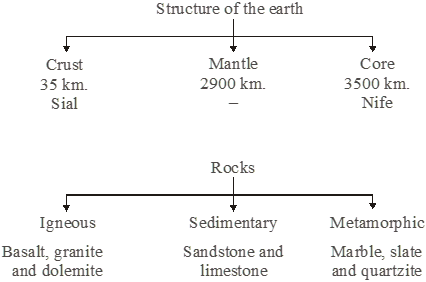
* INTRODUCTION
Our earth is unique as it has all the necessary elements for living beings to exist. The earth comes into existence some five billion years ago. In the beginning, it was extremely hot and molten, but it slowly cooled and acquired the present form. The denser elements, such as iron and nickel gathered in the interior and the lighter ones, such as silicon and aluminium, formed the exterior. Let us take a closer look at the earth’s structure in this chapter.
* STRUCTURE OF THE EARTH
Layers of the Earth
The earth consists of three concentric layers—the crust, the mantle and the core.
The crust
(i) The uppermost layer of the earth is known as the crust.
(ii) The crust is very thin, with an average thickness of about 35 km.
(iii) If we could think of the earth as an egg, the crust could be regarded as the shell. However.
(iv) The crust is not uniformly thick at all places. It is thinner under the oceans and thicker under the continents.
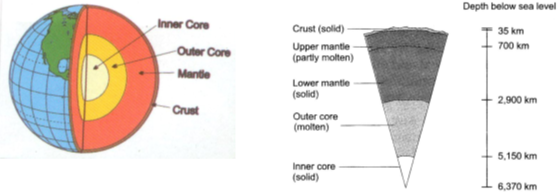
The structure of Earth The layers of the earth
The upper part of the continental crust, which is rich in silica and aluminium, is called sial.
The lower part of the continental crust and the whole of the oceanic crust are composed mainly of denser materials rich in silica and magnesium. They are together called sima.
The surface of the crust is also quite uneven. For example, Mount Everest, the highest mountain peak in the world, is 8,848 metres above sea level, while the world’s deeps point, located in the Mariana Trench in the Pacific Ocean, is 11,034 metres below sea level.
The mantle
(i) Below the crust lies the mantle. It extends up to a depth of about 2,900 km.
(ii) Its chief constituents are silicates of iron and magnesium.
(iii) Both the temperature and the density of the mantle increase with increasing depth towards the centre of the earth.
The mantle has two parts :

The Core
(i) The innermost layer of the earth is called the core.
(ii) It is about 3,500 km thick.
(iii) It is the densest layer. It is believed to be made up of heavy metals like iron and nickel, and is called nife.
The temperatures at the core are high enough to melt all metals. The study of seismic waves shows that the outer part of the core is molten, while its innermost part is solid.
* The Rocks
(i) The earth’s is made up of rocks. Any natural mass of minerals matter that makes up the earth’s crust is called rock. Rock can be of different colour, size and texture.
(ii) Rocks are made up of minerals.
(iii) Minerals are naturally occurring chemical compounds. The minerals feldspar and quartz (silica) are common constituents of rocks.
(iv) Minerals vary in colour, texture, hardness and lustre.
(v) Diamond is the hardest known mineral. Even some edible substances, like halite, or rock salt, are minerals.
(vi) Some rocks contain useful minerals from which metals, like iron, copper and gold can be extracted. These minerals are called ores. Rocks like marble, granite, basalt and sandstone are good building materials.
(vii) Based on how they were formed, rocks may be of three types—igneous, sedimentary and metamorphic.
Igneous Rocks
(i) Deep below the earth’s surface, rocks are in a molten state called magma.
(ii) When magma cools and solidifies, it forms a very hard rock known as igneous rock (igneous means ‘of fire’).
(iii) Much of the earth’s crust is made up of igneous rocks. Igneous rocks are called primary rocks, as these were the first rocks formed when the earth’s crust solidified.
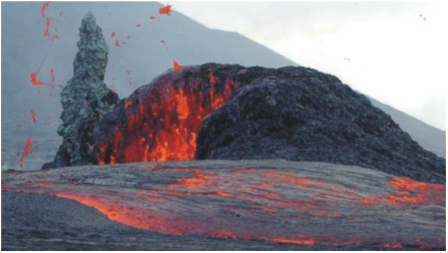
(iv) Igneous rocks are formed either on the surface of the earth or below it.
(v) Extrusive igneous rocks are formed when magma cools and solidifies on reaching the surface. The magma that reaches the surface is known as lava. As the lava cools and solidifies rapidly on the surface, the minerals present in it form very small crystals. Rocks formed in this manner have a fine-grained texture due to the presence of these tiny crystals. The texture, however, is not visible to the naked eye. Basalt, andesite and rhyolite are examples of extrusive igneous rocks.
(vi) Below the earth’s surface, the process of cooling of magma is much slower. The slow cooling allows large crystals of minerals to form. Igneous rocks formed in this way are, therefore, coarse grained. They are known as intrusive igneous rocks. Granite and gabbro are examples of such rocks.
Sedimentary Rocks
(i) Running water, wind and moving ice carry small particles of rock. When these rock particles are deposited on land or on the beds of oceans or rivers, they are called sediments. Sediments are deposited in layers. They harden over the years because of the weight of the layers above and the presence of cementing materials like lime.
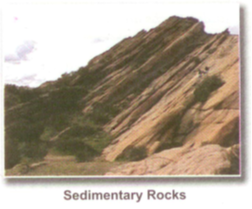
(ii) When the layers are formed under water, the weight of the water also helps in hardening. Rocks formed by the deposition and hardening of layers of sediment are called sedimentary rocks.
(iii) Such rocks are usually made up of layers of different composition. Sandstone, limestone, shale, gravel, clay and conglomerate are examples of sedimentary rocks.
(iv) Coal and Petroleum occurs in sedimentary rocks. Coal and Petroleum has been formed by the decay of plant and animal remains that were buried with sediments millions of years ago.
(v) The remains of plants and animals trapped within layers of rock are called fossils. Hence, petroleum and coal are called fossil fuels.
Metamorphic Rocks
(i) The word ‘metamorphosis’ means change of form. Igneous and sedimentary rocks change their form under very high temperature or pressure. Such ‘changed’ rocks are known as metamorphic rocks.
(ii) Metamorphic rocks are usually very hard. Some common examples of such rocks are marble (formed from limestone), slate (formed from shale), and quartzite (formed from sandstone).
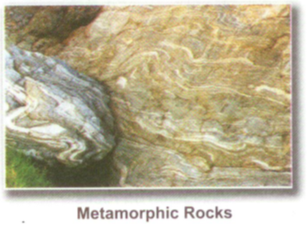
Rocks undergo a cycle of transformation, often called the rock cycle
Magma rising from depths below the earth’s surface produces igneous rocks. The breaking down of different types of rocks produces sediments from which sedimentary rocks are formed. Extreme heat and pressure may cause igneous and sedimentary rocks to form metamorphic rocks. When rocks are melted by heat, new magma is formed.
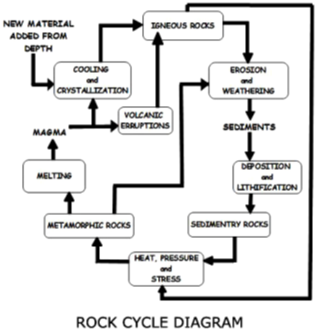
Advantages of Rocks
The study of rocks is called petrology. Rocks can be used for various purposes.
1. As building materials — granite, basalt, sandstone and marble.
2. As fuels — coal and petroleum.
3. As sources of chemicals — potash and phosphates found in sedimentary rocks.
4. As sources of metals — iron, gold and copper from ores.
5. As sources of precious stones — gems and diamonds.
6. Storehouse of fossils.
* Glossary
Crust the uppermost solid layer of the earth
Mantle the layer of the earth below the crust
Asthenosphere a soft layer in the upper mantle
Lithosphere the solid layer comprising the crust and the uppermost part of the mantle, which floats on the asthenosphere
Core the innermost layer of the earth, with a molten outer part and a solid inner part
Magma molten rock found below the earth’s surface
Lava magma which has come out onto the earth’s surface
Igneous rock a type of rock formed by the cooling and hardening of lava or magma
Sedimentary rock a type of rock formed by the deposition and hardening of layers of sediment
Metamorphic rock a type of rock changed from its original form due to heat or pressure
Fossils the remains of the dead plants and animals trapped in the layers of rocks are called fossils
Illustration 1
Core and the Crust
Solution
Core Crust
• It is the inner most part of the Earth. • The uppermost layer over the Earth’s surface.
• Composed of nickel and Iron. • It is mainly composed of Silicon and Aluminium.
Illustration 2
Rocks and Minerals
Solution
Rocks Minerals
• Any natural mass of mineral matter that makes up the earth’s crust. • They are naturally occurring inorganic substances made up of one or more elements.
• They may or may not be crystalline in structure. • They have a crystalline structure.
• They can be of different colours, sizes and textures. • They have definite chemical compositions and physical characteristics.
Illustration 3
Igneous and Sedimentary rocks
Solution
Igneous rocks Sedimentary rocks
• Formed by cooling and solidification of magma into lava. • Formed due to compaction of weathered and eroded material transported and deposited by the agents of gradation in low lying areas. The weight of the overline rocks or water solidifies these materials.
• They are called primary rocks as they appeared first on the surface of Earth. • Such rocks have layers or strata and are called stratified rocks.
• They have a crystalline structure and are generally associated with metallic minerals
• They have a layered structure as they have been laid down in layers or strata, e.g. sandstone, limestone, shale.

 Param Publication
Param Publication
